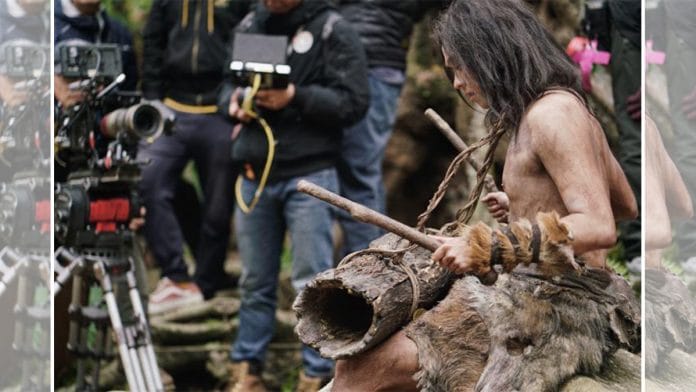New Delhi: When we think of films about Peking Man — an extinct human primate thought to be the direct ancestor of the modern Chinese — the 1977 adventure and horror flick The Mighty Peking Man, which depicted the primate as a giant Himalayan beast, comes to mind. Given that the film sought to capitalise on the hype surrounding King Kong (1976), it at best offered a caricature of Peking Man.
Fast forward to 2022 and a new docu-fiction film, Peking Man: The Last Secret of Mankind, seeks to tell the story of human origins in East Asia, specifically the evolution of six primitive ethnic groups such as Peking Man, Yuanmou Man and Lantian Man.
Produced by Chinese state-owned China Media Group (CMG) and French company, 10.7 Production, the documentary is French director Jacques Malaterre’s attempt to top his hugely successful 2003 film A Species Odyssey that illustrated the birth of the first men.
“All the films made before the year 2000 are often caricatural because the knowledge we had at that time about prehistoric men described them as shaggy, unintelligent, and very primitive beings. Very few of these films can still be watched today without risking making the audience laugh,” Malaterre told ThePrint, adding that he consulted many scientists and paleontologists for his latest project.
Malaterre wrote the script with famed French anthropologist Yves Coppens, who died earlier this year. He was also advised by French paleontologist Antoine Balzeau and in China, worked with Professor Gao Xing and his team at the Chinese Academy of Sciences, Beijing.
On 21 December, extracts of the $6 million film debuted at Hainan Island International Film Festival in Hainan, China. The film is set to be broadcast by CCTV9 in China next summer and by France 2 in France in the second half of 2023.
The film also comes on the heels of a recent discovery of an ancient skull in China’s Yunyang county, believed to be from the extinct Homo erectus species.
Also Read: What 7,200-yr-old fibres from Indus Valley found in Israel tell us about cotton domestication
China’s zero Covid policy
In June 2020, Franck Riester, French Minister of Culture, and Shen Haixiong, president of China Media Group, announced that they would be working towards an archeology documentary on the lineage of the Peking Man.
“China and France must deepen exchanges and cooperation, look for the origins of human culture, and build a spiritual fortress of human civilization facing current epidemic,” Shen had said at the time.
According to the film’s producer, Victor Robert, this is not an intergovernmental project, although governments of both countries are closely supporting the project.
Asked how Covid-19 affected the production of this film, Robert told ThePrint: “I won’t hide it from you, the project was very difficult to set up and to finance. The director Jacques Malaterre was supposed to go to China with about 20 people. He finally got on the plane alone in November 2021 and I didn’t think he would come back with a film.”
Filming began in February for a brief period of 40 days, until Covid-19 lockdowns resumed in major Chinese cities such as Shanghai.
“Natacha De Villers, our producer in China, worked miracles with Jacques. We shot for about 40 days, just between the Chinese New Year and a new confinement of the country. A miracle. For all of us, the miracle took a long time to come and we already had three years of preparation and bad nights under our belts,” added Robert.
According to Malaterre, more than 1,800 Covid-19 tests were conducted during filming for a team of 200 people.
The film was shot in many locations in China, from the far north in the icy plains near Mongolia to the tropical forests of southern China on Hainan Island.
Also Read: ‘Oldest’ ice sample found in Antarctica, offers look at climate 5 million years ago
3D prehistoric animals, shooting in the wild
In order to reconstitute a fictional prehistoric setting that is scientifically accurate, Malaterre spent a year with graphic designers and special effects experts to create prehistoric animals in 3D, such as 3-meter-tall apes and saber-toothed tigers.
Sound design, costumes, props and especially the use of make-up to create prehistoric faces, were a major challenge.
“It takes each actor more than four hours before shooting to transform a man of today into a prehistoric man of yesterday and more than an hour and a half of make-up removal after the film has been shot,” said Malaterre.
“Each day is a real challenge to make all these elements work together in a shoot done in the wild with all the hazards that this entails,” he added.
More than 1,200 Chinese actors auditioned for the film, out of which roughly hundred were selected. Selected actors underwent rehearsals for two and a half months prior to shooting.
Asked how audiences will receive the film, Malaterre said: “Fictional documentaries that retrace the history of our ancestors are very popular with different audiences around the world, and particularly with families. In fact, Chinese prehistory, like European prehistory, African prehistory and other prehistories have a lot of similarities and tell the same story, with only a few thousand years of difference.”
(Edited by Anumeha Saxena)
Also Read: Indian students, expats cautious amid China’s widespread protests against strict Covid policy






